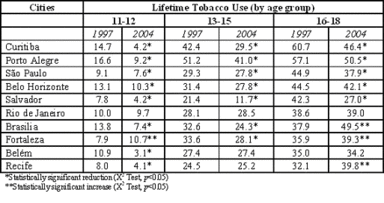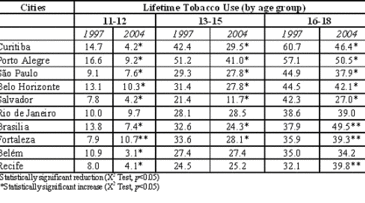Using meta-analysis, researchers observed that exposure to pro-tobacco marketing increased the odds of youth holding positive attitudes toward tobacco use, and more than doubled the odds of initiating tobacco use compared to young people that had not been exposed (Wellman, Sugarman, DiFranza, & Winickoff, 2006). These researchers concluded that pro-tobacco marketing and media stimulated tobacco use among youth; the investigators suggested that, to protect children, societies ban all tobacco promotions. It is uncertain, however, whether such bans will have the desired significant protective effect. This week’s ASHES examines a study by Galduroz, Fonseca, Noto, and Carlini (In press), which examines tobacco use before and after Brazil instituted a pro-tobacco media ban.
Researchers conducted two surveys (i.e., 1997 and 2004) in the ten largest cities in Brazil; these surveys targeted middle school (i.e., fifth grade to eighth grade) and high school students. Both surveys used identical methodologies and questionnaires to ensure the comparability of results. Students answered a self-administered questionnaire, developed by the WHO’s Research and Reporting Project on the Epidemiology of Drug Dependence, about sociodemographic data (i.e., gender, age, school grade, socioeconomic status) and patterns of use of several drugs (e.g., tobacco, marijuana, cocaine, etc.). Researchers defined lifetime tobacco use as at least once in an individual’s lifetime and heavy use as using tobacco twenty or more times in the month prior to the survey. Researchers analyzed the results by comparing group membership using Chi-Square statistical tests.
The distribution of gender among the respondents was similar in both survey years; in 1997, there were 41.6% males and 54.2% females, compared to 44.2% males and 50.5% females in 2004. This difference was not statistically significant. Overall, the age group with the largest concentration of participants was the 13-15 year-old age group. Furthermore, middle school students comprised the majority of participants (i.e., 65.2% in 1997 and 71.0% in 2004).
In 1997, 32.7% of students surveyed in Brazil had used tobacco during their lifetime; by 2004, the prevalence decreased to 25%. Overall lifetime use of tobacco was significantly lower in 2004 compared to 1997 for 7 of the 10 cities surveyed. For the remaining three cities, Fortaleza, Recife, and Rio de Janeiro, there were no significant changes. Across age groups, rates of lifetime use also were significantly lower in 2004 than in 1997. However, there was a significant increase in lifetime use among the 11-12 year-olds in Fortaleza as well as the 16-18 year-old age group in both Brasilia and Recife (Table 1).

Figure. Comparison of lifetime use of tobacco between age groups for both survey years (1997-2004). Click image to enlarge.
There were several important limitations to this study. First, the results of the study do not necessarily mean that the ban on pro-tobacco media is a cause for the drop in tobacco use. It is possible that other unmeasured anti-smoking initiatives in Brazil helped to bring down these rates. Therefore, the effectiveness of the ban remains uncertain. Also, the lack of a control group further hinders researcher’s ability to assess the effectiveness of the ban. Researchers were not able to compare Brazil to a similar country that did not institute the same policy regulating against pro-tobacco media. Finally, the sample was not randomized and only included 11-18 year-olds who were in the education system. Therefore, the sample might not have been representative of Brazil; in addition, the sample did not include the most at risk children – those who did not attend school during the data collection period or not at all.
Despite these limitations, this study provides us with a unique examination of how an anti tobacco media policy might affect youth. Nevertheless, the desired effect of such a ban seems to be limited. Future research is needed to assess the mechanisms on which a ban on pro-tobacco media might work. It is important to explore this and other options (e.g., raising cigarette prices, raising the tobacco tax, other prohibitions, etc) in light of the excessive medical and societal costs caused by tobacco-related morbidity and premature mortality.
–Juan Molina.
References
Galduroz, J. C. F., Fonseca, A. M., Noto, A. R., & Carlini, E. A. Decrease in tobacco use among Brazilian students: A possible consequence of the ban on cigarette advertising? Addictive Behaviors, In Press, Corrected Proof.
Wellman, R. J., Sugarman, D. B., DiFranza, J. R., & Winickoff, J. P. (2006). The Extent to Which Tobacco Marketing and Tobacco Use in Films Contribute to Children’s Use of Tobacco: A Meta-analysis. Arch Pediatr Adolesc Med, 160(12), 1285-1296.
What do you think? Please use the comment link below to provide feedback on this article.




